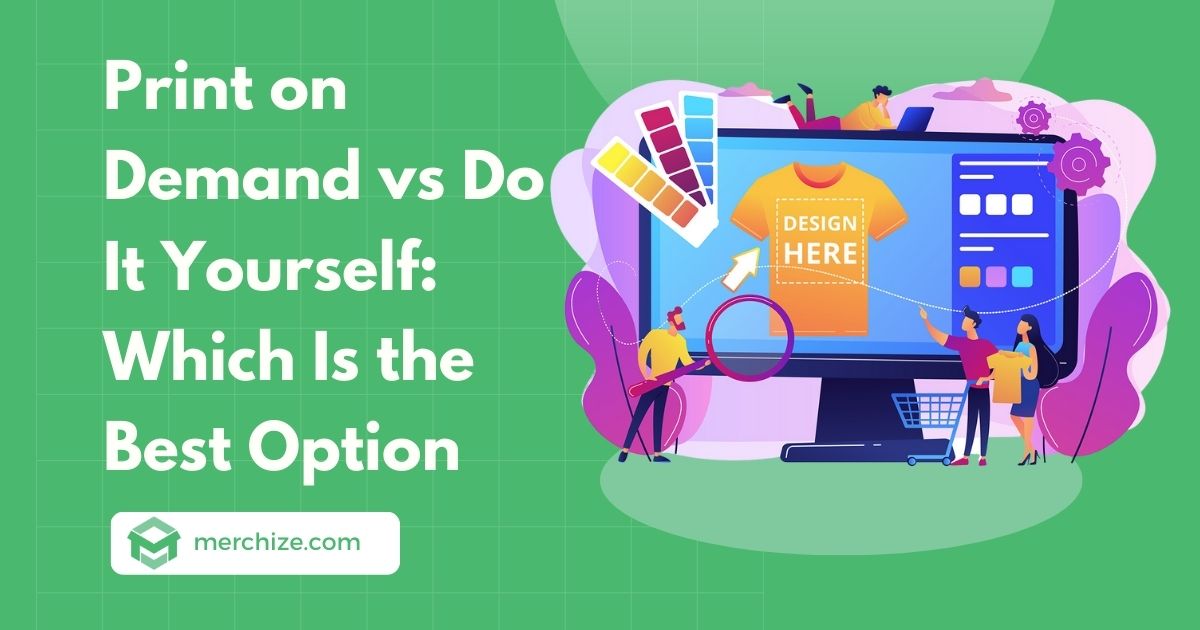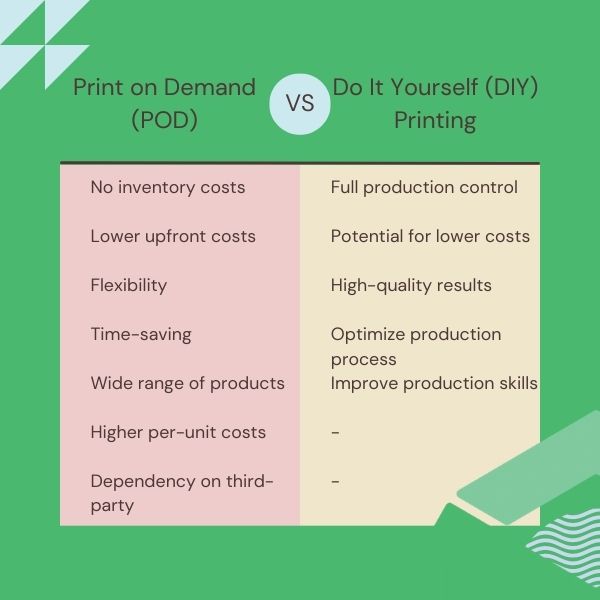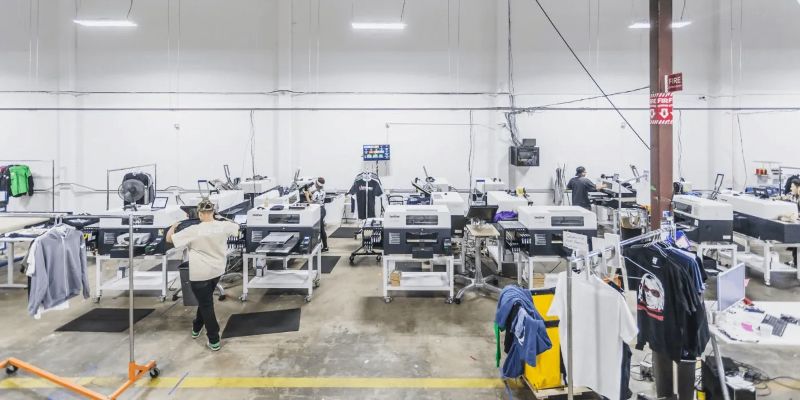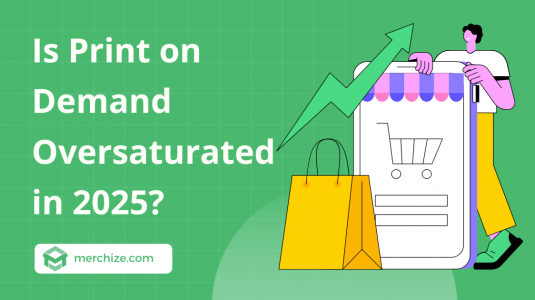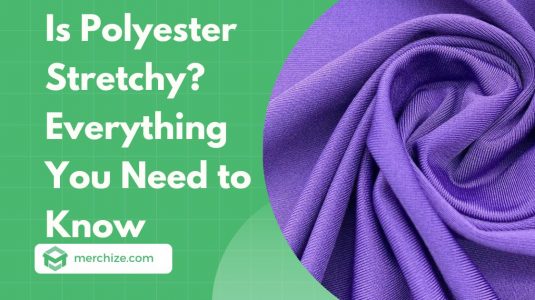Contents
Operating an ecommerce business in 2024 calls for nonstop optimization between cost, quality and branding – an endless balancing act. This tension clearly emerges when exploring order fulfillment options. Do you take on printing, warehousing and shipping solo or leverage convenient print-on-demand (POD) services? As online retail grows increasingly complex, print-on-demand (POD) introduces an enticing alternative to traditional do-it-yourself (DIY) methods for producing merch. But is POD truly a silver bullet solution?
In this decisive guide, we extensively compare POD against going the DIY route for order fulfillment. By peering into the mechanics behind each model, you’ll grasp the upsides and downsides regarding metrics like expenses, quality control, branding potential and ease of use based on your business needs. Should you ride the POD wave or steer your own ship?
Our goal is to equip you with insider intel to strategically plot your fulfillment plan, no matter your current size or bandwidth. We’ll unpack real-world POD implementations, outlining integration options and hidden fees. You’ll also get pro tips for optimizing in-house printing and distribution chains. Arm yourself with transparent insights to confidently build a smarter merch production pipeline.
Exploring the Fundamentals of Print on Demand vs Do It Yourself Printing
To make a smart choice between print on demand and do it yourself, it’s super important to dive into the core elements of each method. Gaining a thorough understanding of their unique features, benefits, and challenges will help you determine which approach is best suited for your specific goals, requirements, and resources.
Print on Demand (POD)
Print on demand is a New-age printing that lets businesses print products only when needed, and say goodbye to those annoying storage issues. With POD, you team up with another company that handles the printing, packing, and shipping, letting you focus on other aspects of your business, such as marketing, product development, and customer service. Furthermore this method is super useful for businesses aiming to test new designs or products without committing to a significant upfront investment or those with not much storage space and resources.
In-depth benefits of POD:
- Eliminate the need for storage and inventory management, reducing overhead costs.
- Minimizes upfront investment, as you only pay for what you sell, lowering the starting hurdles for new businesses.
- Provides flexibility to test and iterate new designs or products with minimal risk, boosting new ideas.
- The third-party provider handles the production, logistics and delivery rules, freeing up time and resources for other business activities.
- Can cater to a wider range of products and designs, as there is no need to commit to large quantities.
Potential challenges of POD:
- Costs per unit are higher than with DIY printing, which could affect profit margins.
- You have little control over the speed, quality, and production process because you are dependent on the other company handling things.
Do It Yourself (DIY) Printing
Do it yourself printing entails setting up and managing your in-house printing equipment and processes. With this approach, you’re in charge of the whole shebang, from picking out your gear and stuff to handling the printing, packing, and sending product out. Businesses who value customisation and want complete production control, as well as those with the finances and know-how to do your own printing, then DIY might be your jam.
In-depth benefits of DIY Printing:
- Full control over production standards, levels of customisation, and delivery schedules, allowing you to meet unique customer requirements.
- As you make more items, the cost of each item can go down, which can mean more money in your pocket.
- Direct participation at every stage of manufacturing, from design to delivery, guarantees high-quality results.
- Opportunity to optimize production processes for maximum efficiency and cost savings, providing a competitive edge.
- Ability to acquire internal experience and understanding of printing methods and tools, gradually enhancing your production skills.
Potential challenges of DIY Printing:
- Requires a substantial upfront investment in equipment, materials, and potentially additional staff, which may present financial barriers for some businesses.
- Increased responsibility for inventory management, storage, and potential unsold stock, which can lead to higher costs and resource allocation.
- Scalability depends on your own production capacity, which may necessitate further investments as your business grows, in addition to the need to manage production during peak periods.
- Time and resources must be dedicated to managing production, potentially detracting from other aspects of your business, such as marketing and customer service.
Comparing Costs: Print on Demand vs DIY
Cost is a primary factor when choosing between print on demand and do it yourself. In this section, we’ll dive deeper into the cost implications of both methods and provide a comparison table to help you visualize the differences.
Print on Demand Costs
Print on Demand Costs typically involves paying a base price for each printed item when using POD services, which covers the cost of the blank product, printing, and a markup for the service provider. For using their platform, some providers may also charge a monthly or yearly subscription. Although POD might save initial expenses, it’s important to remember that, especially for large order volumes, the per-unit cost may be higher than DIY printing.
Print on Demand Factory can produce items in bulk
Do It Yourself Costs
DIY printing necessitates an investment in printing supplies, tools, and sometimes more personnel to oversee the production process. Despite the potentially high initial cost, depending on your production volume, the cost per unit of each item may be lower than with POD. DIY printing may ultimately be less expensive when your company expands due to economies of scale.
Print on Demand DIY cannot produce items in large quantities
Comparison Table: Print on Demand and Do It Yourself Costs
| Print on Demand (POD) | Do It Yourself (DIY) | |
|---|---|---|
| Upfront Costs | Minimal; pay base price for each item | Higher; investment in printing equipment, materials, and potentially additional staff |
| Per-unit Costs | Higher; base price includes blank product, printing, and service provider markup | Lower; economies of scale make per-unit costs more cost-effective as production volume increases |
| Platform Fees | Possible monthly or annual fee, depending on the provider | None |
| Inventory Costs | No inventory storage and management costs | Costs associated with inventory storage, management, and potential unsold stock |
| Shipping Costs | Varies by provider, may be reduced with a global network of printing facilities | Depends on |
My friend said that he began with print on demand (POD), which is cost-effective and requires no inventory, but offers lower profits and less branding control. Switching to self-printing and shipping allows him to create unique packaging and include freebies, enhancing customer experience. Although it demands more resources, it’s better for combining products and branding. Gradually, he expanded my product range, balancing both methods based on product type and business growth. So start with POD and then gradually move to DIY to maximize profits
Evaluating Production Efficiency: Print on Demand and Do It Yourself
Efficiency is a crucial aspect when comparing print on demand and do it yourself printing methods. In this section, we’ll discuss the efficiency implications of each method, as well as the benefits of using a service like Merchize for your POD needs.
Print on Demand Efficiency
POD services streamline the production process by eliminating inventory management, reducing the risk of overstocking or understocking products. Additionally, POD providers like Merchize typically have a global network of printing facilities, ensuring faster shipping times and reduced shipping costs for your customers. This makes POD an attractive option for businesses looking to scale quickly and reach international markets.
DIY Printing Efficiency
Do it yourself printing offers a high degree of control over the production process, which can result in enhanced efficiency if effectively managed. However, this method demands a significant investment in time and resources to optimize processes, handle inventory, and oversee shipping logistics. For businesses with constrained resources, managing these aspects can be challenging. Additionally, the capacity of your own manufacturing is what determines how large DIY printing can be potentially necessitating additional investments in equipment and personnel as your business expands.
Comparison Table: Print on Demand vs Do It Yourself Efficiency
| Print on Demand (POD) | Do It Yourself (DIY) | |
|---|---|---|
| Inventory Management | No inventory management needed; reduced risk of overstocking or understocking | Requires inventory management; potential risk of overstocking or understocking |
| Production Process Control | Limited control, dependent on the chosen provider | Full control over the production process, allowing for customization and optimization |
| Scalability | Easily scalable with global network of printing facilities, like Merchize | Scalability is limited by your own production capacity and may require further investments |
| Shipping Times and Costs | Faster shipping times and reduced costs due to global network of printing facilities | Shipping times and costs depend on your own shipping logistics and available resources |
| Resource Requirements | Fewer resources required; third-party provider handles production and shipping | Requires investment in time, resources, and potentially additional staff for production and shipping management |
By analyzing the production efficiency of print on demand and do it yourself methods, as well as considering the benefits of using a service like Merchize for your POD needs, you can determine which option is better suited for your business needs, resources, and growth plans.
Conclusion
When deciding between print on demand and do it yourself printing, it’s essential to weigh the pros and cons of each method in terms of cost, efficiency, and control. Print on demand, particularly when using a reputable provider like Merchize, can be an attractive option for businesses seeking to minimize upfront costs, streamline production, and scale quickly. On the other hand, do it yourself printing offers more control over the production process, allowing for greater customization and potentially lower per-unit costs for businesses willing to invest in the necessary equipment and resources. By carefully considering your unique business needs and objectives, you can make the best choice between print on demand vs do it yourself printing methods to optimize your production processes and maximize your success.
